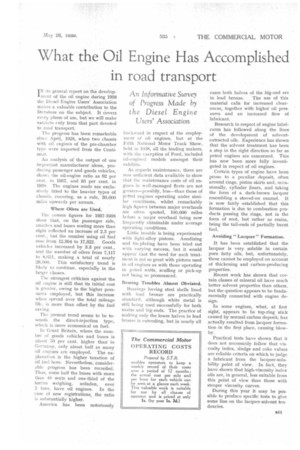What the Oil Engine Has Accomplished in road transport
Page 45

If you've noticed an error in this article please click here to report it so we can fix it.
An informative Survey of Progress Made by the Diesel Engine Users' Association
IN its general report on the develop ment of the oil engine during 1938 the Diesel Engine Users' Association makes a valuable contribution to the literature on the subject, It Covers every phase of use, but we will make extracts cnly from that part devoted to road transport.
The progress has been remarkable since April, 1928, when two chassis with oil engines of the pre-chamber type were imported from the Continent.
An analysis of the output of one important manufacturer alone, producing passenger and-goods vehicles, show3 the oil-engine ratio as 92 per cent, in 1937, and 95 per cent. in 1938. The engines made are exclusively fitted to the heavier types of chassis, covering, as a rule, 30,000 miles upwards per annum.
Where Oilers are Used.
The census figures for 1937-1938 show that, on the passenger side, coaches and buses seating more than eight reflected an increase of 2.3 per cent., but the number using oil fuel rose from 12,994 to 17,322. Goods vehicles increased by 3.8 per cent., and the number of oilers from 7,117 to 8,621, making a total of nearly 26,000. This satisfactory trend is likely to continue, especially in the larger classes.
The strongest criticism against the oil engine is still .that its initial cost is greater, owing to the higher pressures employed, but this increase when spread over the total mileage life, is more than offset by the fuel saving.
The present trend seems to be towards the direct-injection type, which is more economical on fuel.
In Great Britain, where the number of goods vehicles and buses is about 50 per cent. higher thanin Germany, only about half as many oil engines are employed. The explanation is the higher taxation of oil fuel here. Nevertheless, considerable progress has been recorded. Thus, some half the buses with more than 48 seats and one-third of the lorries weighing, unladen, over 3 tons, have oil engines. In the case of new registrations, the ratio is substantially higher.
America has been notoriously backward in respect of the employment of oil engines, but at the Filth National Motor Truck Show, held in 1938, all the leading makers, with the exception of Ford, included oil-eligined models amongst their exhibits.
As regards maintenance, there are now sufficient data available to show that the maintenance costs of oil engines in well-managed fleets are not greater—possibly, less—than those of petrol engines operating under similar conditions, whilst remarkably high figures between major overhauls are often quoted, 100,000 miles before a major overhaul being now frequently obtainable under average operating conditions.
Little trouble is being experienced with light-alloy pistons. Anodizing and tin-plating have been tried out with varying success, but it would appear that the need for such treatment is not so great with pistons used in oil engines as with those operating in petrol units, scuffing or pick-up not being so pronounced.
Bearing Troubles Abnost Obviated.
Bearings having steel shells lined with lead bronze are practically standard, although white metal is still being used successfully for both mains and big-ends. The practice of making only the lower halves in lead bronze is extending, but in nearly all cases both halves of the big-end are in lead bronze. The use of this material calls for increased clearances, together with higher oil pressures and an increased flow of lubricant.
Research in respect of engine lubricants has followed along the lines of the development of solventextracted oils. Experience has shown that the solvent treatment has been a step in the right direction so far as petrol engines are concerned. This has now been more fully investigated in respect of oil engines.
Certain types of engine have been prone to a peculiar deposit, often around rings, piston skirts and, occasionally, cylinder liners, and taking the form of a dark-brown lacquer resembling a stoved-on enamel. It is now fairly .established that this formation is due to combustion products passing the rings, not in the form of soot, but rather as resins, being the tail-ends of partially burnt fuel.
Avoiding " Lacquer " Formation.
It has been established that the lacquer is very soluble in certain pure fatty oils, but, unfortunately, these cannot be employed on account of thickening and carbon-producing properties.
Recent work has shown that certain classes of mineral oil have much better solvent properties than others, but the question appears to be fundamentally connected with engine design.
In some engines, what, at first sight, appears to be top-ring stick caused by normal carbon deposit, has ,actually resulted from lacquer formation in the first place, causing blowby.
Practical tests have shown that it does not necessarily follow that viscosity index, sludge and coke values are reliable criteria on which to judge a lubricant from the lacquer-solubility point of view. In fact, they have shown that high-viscosity index oils are, in general, less suitable from this point of view than those with steeper viscosity curves.
During this year it may be possible to produce specific tests to give some line on the lacquer-solvent tendencies.




















































































